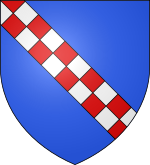User:Bjohnsonlmu/sandbox

The family of the Hauteville (
Origins
The familial origins had roots from the
The first of the family well known to us is
Mezzogiorno
The eldest of the twelve sons,
It was Robert who began the conquest of Sicily which was to yield a kingdom seventy years later, as he renewed the war against Byzantium with vigour. Along with the valiant warriorship displayed by his youngest brother,
Roger bequeathed a powerful state to his young sons,
Kingdom of Sicily
On William's death in 1127, the union of the duchy and the county was effected and Roger's quest for a crown began. Believing kings to have ruled Palermo in antiquity, Roger threw his support behind the Antipope Anacletus II and was duly enthroned as king of Sicily on Christmas Day 1130.
Roger spent most of the decade beginning with his coronation and ending with his great
Roger's son and successor was William the Bad, though his nickname derives primarily from his lack of popularity with the chroniclers, who supported the baronial revolts William crushed. His reign ended in peace (1166), but his son, William the Good, was a minor. During the boy regency until 1172, the kingdom saw turmoil which almost brought the ruling family down, but eventually the realm settled down and the reign of the second William is remembered as two decades of almost continual peace and prosperity. For this more than anything, he is nicknamed "the Good." His death without heirs in 1189 threw the realm into chaos, however.
Crusades
The aforementioned Bohemond received in 1088, as a consolation, the principality of Taranto district from the duchy of Apulia which fell as per their father's will to his brother Roger Borsa. Bohemond did not long remain to enjoy his new principality, for while besieging Amalfi with his uncle and brother, he joined a passing band of Crusaders on their way to Palestine. Among his army was a nephew of his, a young man named Tancred.
Bohemond was the natural leader of the crusading host but, through a trick, he took
Tancred had great luck in carving out a principality around Galilee with the grants of Godfrey of Bouillon, but he relinquished this in 1101.
Genealogy
Tancred and his first wife Muriel (or Muriella) had the following issue:
- count of Apulia(1042–1046)
- count of Apulia(1046–1051)
- count of Apulia(1051–1057)
- Capitanate(d.1071)
- Sarlo (or Serlo) I, heir to estates in Normandy
- Sarlo II (d.1072) married the daughter of Roger de MoulinsCount of Boiano.
- Sarlo III descending from which the Marquis Sarlo of Calabria
Tancred and his second wife Fressenda (or Fedesenda) had the following issue:
- duke of Apulia(1059–1085)
- prince of Taranto (1088–1111) and Antioch(1098–1111)
- prince of Taranto (1111–1128) and Antioch(1111–1131)
- Constance, Princess of Antioch (1131–1163)
- duke of Apulia(1085–1111)
- duke of Apulia(1111–1127)
- Guy, duke of Amalfi and Sorrento (d.1107)
- Robert Scalio (d.1110)
- Emma of Apulia
- Tancred, Prince of Galilee (1072–1112)
- William
- Capitanate(1056–1059)
- William, count of the Principate (1056–1080)
- Richard of Salerno, regent of the County of Edessa (1104–1108, d.1114)
- Roger of Salerno, regent of the Principality of Antioch (1112–1119)
- Richard of Salerno, regent of the County of Edessa (1104–1108, d.1114)
- Aubrey (also Alberic, Alberad, Alvered, Alvred, or Alfred), stayed in Normandy
- Hubert (also Humbert), stayed in Normandy
- Tancred, stayed in Normandy
- count of Sicily(1071–1101)
- Syracuse(1091–1092)
- Geoffrey, count of Ragusa
- Mauger, count of Troina
- count of Sicily(1101–1105)
- king of Sicily(1130–1154)
- duke of Apulia(1134–1148)
- king of Sicily(1189–1194)
- king of Sicily(1193–1194)
- king of Sicily(1194)
- Tancred, prince of Bari (1132–1138)
- prince of Capua(1135–1144)
- king of Sicily(1154–1166)
- duke of Apulia(1154–1161)
- Robert
- king of Sicily(1166–1189)
- duke of Apulia(1181)
- prince of Capua(1166–1172)
- Henry
- prince of Taranto(1128–1154)
- queen of Sicily(1194–1198)
- king of Sicily(1198–1250)
Relatives of unknown relationship include:
- Syracuse (fl.1104)
- Syracuse(fl. 1162), possibly a son of Roger II or nephew of Roger I.
References
- ^ Hill, James S. The place-names of Somerset. St. Stephen's printing works, 1914, Princeton University. Page 256
- ^ Revue de l'Avranchin et du pays de Granville, Volume 31, Issue 174, Parts 3-4. Société d'archéologie, de littérature, sciences et arts d'Avranches, Mortain, Granville. the University of Michigan.
- ^ Google books, The British Chronicles, Volume 2 By David Hughes, Page 527
- )
- ^ G.A. Loud, William of Apulia (1963). M. Mathieu (ed.). Palermo: Guillaume de Pouille.
{{cite book}}: Missing or empty|title=(help) - doi:10.1177/0968344510376463.)
{{cite journal}}: CS1 maint: date and year (link - .
Sources
- European Commission presentation of The Normans Norman Heritage, 10th-12th century.
- Norwich, John Julius. The Normans in the South 1016-1130. Longmans: London, 1967.
- Norwich, John Julius. The Kingdom in the Sun 1130-1194. Longman: London, 1970.
- Pierre Aubé, Roger II de Sicile. 2001.
- Matthew, Donald. The Norman Kingdom of Sicily. Cambridge University Press: 1992.
- Houben, Hubert. Roger II of Sicily: A Ruler between East and West. Trans. G. A. Loud and Diane Milbourne. Cambridge University Press: 2002.
- Medieval Sourcebook: Alexiad—complete text, translated Elizabeth A. Dawes
- Ralph of Caen. Gesta Tancredi. trans. Bernard S. and David S. Bachrach. Ashgate Publishing, 2005.
Category:European royal families
Category:Norman families
Category:Italo-Normans

